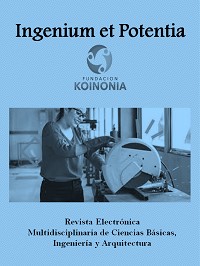Soil-structure interaction analysis in a risk zone with pile foundations, Cuenca, Ecuador
DOI:
https://doi.org/10.35381/i.p.v4i1.2162Keywords:
Civil engineering, construction engineering, construction industry. (UNESCO Thesaurus).Abstract
Buildings in vulnerable areas in Cuenca have been carried out for a long time. In 2018, the city's Risk directorate identified 60 sectors susceptible to movements. Due to the flexible behavior of the soils and the depth of these strata, the need arises to investigate the characteristics of the subsoil, focusing the present research on Paccha risk area, located to the east of the city. Through experimental tests, and with the application of dynamic simulations, the structure of a proposed building was analyzed. Thus, a building with a rigid foundation was studied, then considering soil-structure interaction and finally with piles. Based on the data obtained in an analysis of the level of performance in the event of a rare earthquake for the proposed cases, it can be observed that the consideration of piles, guarantees structural safety in the constructions of the studied area and therefore the tranquility of the occupants of the same.
Downloads
References
ACI Committee 351. (2004). Aci-3513R-04-foundations-for-dynamic-equipment. https://acortar.link/aVS8aO
ACI Committee 351. (2018). ACI 351.3R-18 Report on Foundations for Dynamic Equipment. http://concrete.org/Publications/
American Society of Civil Engineers. (2000). FEMA 356 prestandard and commentary for the seismic rehabilitation of buildings. https://acortar.link/FvJnwD
Applied Technology Council. (1996). ATC-40 Seismic Evaluation and Retrofit of Concrete Buildings Volume 1. https://www.atcouncil.org/pdfs/atc40toc.pdf
Araujo, S., Valette, B., Potin, B., & Ruiz, M. (2021). A preliminary seismic travel time tomography beneath Ecuador from data of the national network. Journal of South American Earth Sciences, 111, 103486. https://doi.org/10.1016/J.JSAMES.2021.103486
ASCE/SEI 41-13. (2014). Seismic Evaluation and Retrofit of Existing Buildings. American Society of Civil Engineers. https://doi.org/10.1061/9780784412855
Bendezu Romero, M., Miguel, L., Bendezú, G., & Claudio, J. (2021). Seismic Performance and Damage State of Reinforced Concrete Frame Buildings Using Fragility Curves in Lima 2021. Retrieved from https://n9.cl/twun4
Bertin, R., & Gasc, C. (1976). Cimentaciones y obras en recalces [Foundations and underpinning works]. (2da ed.). Editores Técnicos asociados.
Braja, D. (2013). Fundamentos de Ingeniería Geotécnica [Fundamentals of Geotechnical Engineering]. Recuperado de https://acortar.link/d7XapV
Braja, D. (2011). Fundamentos ingeniería cimentaciones [Fundamentals of foundation engineering]. Recuperado de https://acortar.link/OICwxz
Clough, R. W., & Penzien, J. (2015). Dynamics of structures. http://parastesh.usc.ac.ir/files/1538888752479.pdf
Dong, W., Mata-Lemus, R., Idrees-Rustom, A., Sánchez-Rodríguez, J., Torres-Moreno, R., Nuñez-Castellanos, E., & Bustamante-Laissle, G. (2022). Assessment of Strength Reduction Factor on Concrete Moment Frames According to the New Venezuelan Seismic Code. https://doi.org/10.3390/buildings12030255
Geotechnical Society. (2006). Canadian Foundation Engineering Manual (4th ed.). Canadian Geotechnical Society.
Hidalgo Bahamontes, A. (2004). Construcción de cimientos [Foundation construction]. (Ed. actual). CEAC.
Hoja Geológica-Cuenca, H. (2009). Hoja Geológica, Cuenca, 2009 (p. 1).
Liu, S., Li, P., Zhang, W., & Lu, Z. (2020). Experimental study and numerical simulation on dynamic soil‐structure interaction under earthquake excitations. Soil Dynamics and Earthquake Engineering, 138, 106333. https://doi.org/https://doi.org/10.1016/j.soildyn.2020.106333
Liu, Y., & Vanapalli, S. K. (2021). Mechanical behavior of a floating model pile in unsaturated expansive soil associated with water infiltration: Laboratory investigations and numerical simulations. Soils and Foundations, 61(4), 929-943. https://doi.org/10.1016/J.SANDF.2021.06.004
Martínez, Á. (2015). Bioconstrucción: como crear espacios saludables, ecológicos y armoniosos [Bioconstruction: how to create healthy, ecological and harmonious spaces]. Ediciones I. Recuperado de https://n9.cl/f7h0d
NEC-SE-CG. (2015). Norma Ecuatoriana de la Construcción, Cargas (No Sísmicas) [Ecuadorian Construction Standard, Loads (Non-Seismic)]. Recuperado de https://cicp-ec.com/documentos/NEC_2015/NEC_SE_CG_Cargas_Sismicas.pdf
NEC-SE-DS. (2015). Norma Ecuatoriana de la Construcción, Peligro Sísmico Diseño Sismo Resistente [Ecuadorian Construction Standard, Seismic Hazard Seismic Resistant Design]. Recuperado de https://acortar.link/HvgMXt
NEC-SE-GC. (2015). Norma Ecuatoriana de la Construcción, Geotecnia y Cimentaciones [Ecuadorian Construction, Geotechnics and Foundations Standard]. Recuperado de https://online.portoviejo.gob.ec/docs/nec6.pdf
Pais, A., & Kausel, E. (1988). Approximate formulas for dynamic stiffnesses of rigid foundations. Soil Dynamics and Earthquake Engineering, 7(4), 213-227. https://doi.org/10.1016/S0267-7261(88)80005-8
Senthil, J., & Muthukannan, M. (2021). Predication of construction risk management in modified historical simulation statistical methods. Ecological Informatics, 66, 101439. https://doi.org/10.1016/J.ECOINF.2021.101439
Stewart, J., Crouse, C. B., Hutchinson, T., Lizundia, B., Naeim, F., & Ostadan, F. (2012). Soil-Structure Interaction for Building Structures. Grant/Contract Reports (NISTGCR), National Institute of Standards and Technology, Gaithersburg, MD. https://tsapps.nist.gov/publication/get_pdf.cfm?pub_id=915495
Vivek, A., & Hanumantha Rao, C. H. (2022). Identification and analysing of risk factors affecting cost of construction projects. Materials Today: Proceedings. https://doi.org/10.1016/J.MATPR.2021.12.228
Wilson, E. L. (2000). Three dimensional static and dynamic analysis of structures: a physical approach with emphasis on earthquake engineering (3rd ed.). Computers and Structures. https://acortar.link/dKcmbV
Published
How to Cite
Issue
Section
License
CC BY-NC-SA : Esta licencia permite a los reutilizadores distribuir, remezclar, adaptar y construir sobre el material en cualquier medio o formato solo con fines no comerciales, y solo siempre y cuando se dé la atribución al creador. Si remezcla, adapta o construye sobre el material, debe licenciar el material modificado bajo términos idénticos.
OAI-PMH URL: https://fundacionkoinonia.com.ve/ojs/index.php/ingeniumetpotentia/oai








